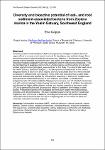Diversity and bioactive potential of leaf-, and root sediment-associated bacteria from Zostera marina in the Yealm Estuary, Southwest England
| dc.contributor.author | Capps, E. | |
| dc.date.accessioned | 2023-12-22T16:05:32Z | |
| dc.date.available | 2023-12-22T16:05:32Z | |
| dc.date.issued | 2023 | |
| dc.identifier.citation |
Capps, E. (2023) 'Diversity and bioactive potential of leaf-, and root sediment-associated bacteria from Zostera marina in the Yealm Estuary, Southwest England', The Plymouth Student Scientist, 16(2), pp. 132-156. | en_US |
| dc.identifier.uri | https://pearl.plymouth.ac.uk/handle/10026.1/21843 | |
| dc.description.abstract |
Increasing antimicrobial resistance (AMR) among human pathogenic bacteria demands urgent efforts to uncover novel natural products for developing new antibiotic drugs. Since terrestrial sources of natural products are overmined, attention in biodiscovery is shifting towards marine microbial ecosystems which are subject to unique environmental stressors. Resulting metabolic adaptations provide potential for potent antibacterial compounds. Thus, the microbiomes of seagrass components in Zostera marina, and the activity of culturable isolates against human pathogens, were explored in this study. The sample site used was in the Yealm Estuary, Southwest England, a location previously unexplored in this context. Seagrass leaves at 20cm and 50cm depths, and root-associated sediment, were collected and plated on selective and non-selective media. DNA was extracted from shallow depth leaves and sediment and purified for 16S amplicon surveying. A total of 207 isolates were subcultured and antibacterial activity of pure colonies was tested. In simultaneous antagonism tests, 26 isolates inhibited Staphylococcus aureus, and 41 inhibited Escherichia coli, with sediment-derived isolates having the most overall activity. In addition, the sediment microbiome had higher alpha diversity indices, and highest operational taxonomic units (OTUs) of genera Bacillus and Sporosarcina, which is consistent with findings in other studies. Predominant genera in the seagrass leaf from 20cm depth were Marinomonas, Colwellia, and Winogradskyella. This study revealed Zostera marina plants in Southwest England to be a rich source of bacteria, including actinobacteria, with potent secondary metabolites which demonstrates the value in exploring new environments for bioactive molecules with pharmaceutical potential. | en_US |
| dc.language.iso | en | en_US |
| dc.publisher | University of Plymouth | en_US |
| dc.rights | Attribution 3.0 United States | * |
| dc.rights.uri | http://creativecommons.org/licenses/by/3.0/us/ | * |
| dc.subject | Antimicrobial resistance (AMR) | en_US |
| dc.subject | antibiotic discovery | en_US |
| dc.subject | natural products | en_US |
| dc.subject | marine bacteria | en_US |
| dc.subject | Zostera marina | en_US |
| dc.subject | seagrass microbiome | en_US |
| dc.subject | microbial diversity | en_US |
| dc.subject | microbial composition | en_US |
| dc.subject | 16S sequencing | en_US |
| dc.subject | actinobacteria | en_US |
| dc.subject | bioactivity | en_US |
| dc.subject | colony iridescence | en_US |
| dc.subject | Escherichia coli | en_US |
| dc.subject | Klebsiella pneumoniae | en_US |
| dc.subject | Pseudomonas aeruginosa | en_US |
| dc.subject | Staphylococcus aureus | en_US |
| dc.subject | Micrococcus luteus | en_US |
| dc.subject | Enterococcus faecalis | en_US |
| dc.title | Diversity and bioactive potential of leaf-, and root sediment-associated bacteria from Zostera marina in the Yealm Estuary, Southwest England | en_US |
| dc.type | Article | en_US |
| plymouth.issue | 2 | |
| plymouth.volume | 16 | |
| plymouth.journal | The Plymouth Student Scientist |




